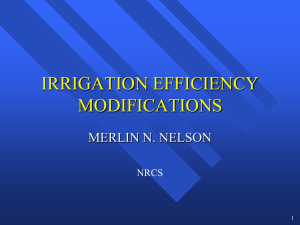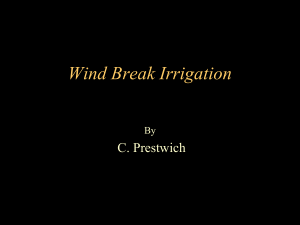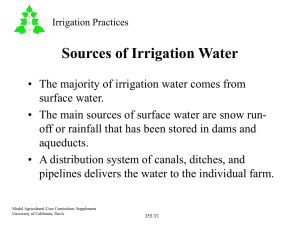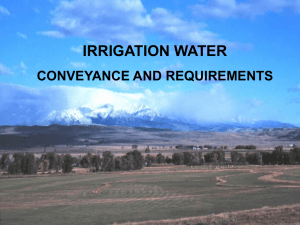Sprinkler Irrigation Management
advertisement
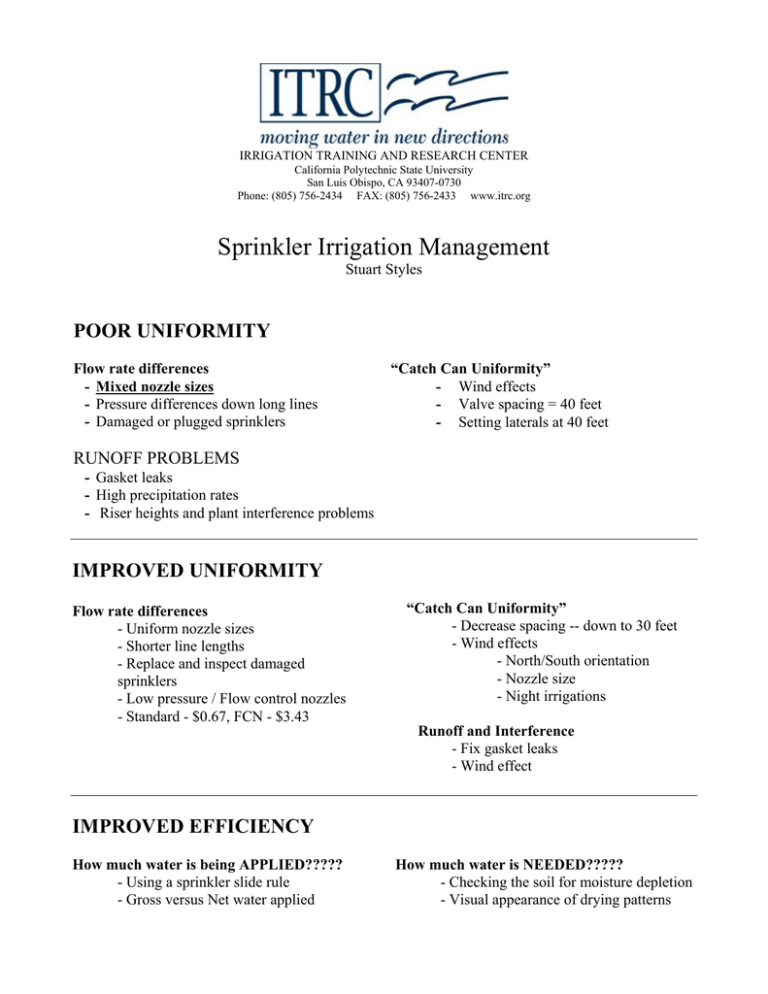
IRRIGATION TRAINING AND RESEARCH CENTER California Polytechnic State University San Luis Obispo, CA 93407-0730 Phone: (805) 756-2434 FAX: (805) 756-2433 www.itrc.org Sprinkler Irrigation Management Stuart Styles POOR UNIFORMITY Flow rate differences - Mixed nozzle sizes - Pressure differences down long lines - Damaged or plugged sprinklers “Catch Can Uniformity” - Wind effects - Valve spacing = 40 feet - Setting laterals at 40 feet RUNOFF PROBLEMS - Gasket leaks - High precipitation rates - Riser heights and plant interference problems IMPROVED UNIFORMITY Flow rate differences - Uniform nozzle sizes - Shorter line lengths - Replace and inspect damaged sprinklers - Low pressure / Flow control nozzles - Standard - $0.67, FCN - $3.43 “Catch Can Uniformity” - Decrease spacing -- down to 30 feet - Wind effects - North/South orientation - Nozzle size - Night irrigations Runoff and Interference - Fix gasket leaks - Wind effect IMPROVED EFFICIENCY How much water is being APPLIED????? - Using a sprinkler slide rule - Gross versus Net water applied How much water is NEEDED????? - Checking the soil for moisture depletion - Visual appearance of drying patterns Sprinkler Slide Rule Example ITRC 1. Use the side that says " PRECIPITATION RATE CALCULATIONS" Opposite from the side that says "IRRIGATION DESIGN CALCULATOR" 2. Read the Pressure of the sprinkler on the top in PSI Example: 60 PSI 3. Move the slide until the nozzle size is at the sprinkler pressure. Example: 7/64" Nozzle 4. Read the sprinkler flow rate at the arrow At 60 PSI with a 7/64" nozzle, the flow rate for one sprinkler is 2.7 GPM 5. Determine the spacing for the sprinklers. Example: The sprinklers are at 30 feet spacing and the laterals are 40 feet = 1,200 Square Feet 6. Determine the Precipitation Rate and the total water applied. Read under 1200 Square Feet (or 30x30), Precipitation Rate = 0.22 in/hr If the set were operated for 6 hours, then the total applied water = 0.22 in/hr x 6 = 1.32 in 7. What happens if the lateral spacing is decreased to 30 feet (everything else is the same)? The spacing is decreased to 30 feet = 900 Square Feet Read under 900 Square Feet, Precipitation Rate = 0.29 in/hr If the set were operated for 6 hours, then the total applied water = 0.29 in/hr x 6 = 1.74 in Answer: About 30% more water is applied Sprinkler and Furrow Irrigation Workshop for Field Managers IRRIGATION SYSTEM EFFICIENCY While they are related, the concepts of efficiency and uniformity are different. It is possible for a system to have high uniformity and low efficiency. The ideal, of course, is to have both high uniformity (giving good appearance) and high efficiency (minimum water use). The irrigation efficiency is a measure of the amount of water stored in the root zone available for the plants to use divided by the amount of water applied during an irrigation. Efficiency is a measure of both the equipment and the management at a site, while uniformity is primarily related to the mechanical performance of the irrigation system. DISTRIBUTION UNIFORMITY Distribution Uniformity (DU) represents how evenly water is made available to plants in the field. Ideally, irrigation methods should apply water uniformly to each plant in a field. Such a method would have a DU of 100%. In fact, no system is capable of applying water so that every plant in a field receives the same amount of water. For all methods, some points in the field are always over and/or under-irrigated. A low DU results in water and energy wastage because excess water must be pumped onto a field to apply enough water at the dry points. Also, a low DU results in excessive chemical and fertilizer leaching since there is excessive water passing through the rootzone. Irrigation system designers must attempt to maximize the uniformity within the cost limitations. Maintenance and operation must attempt to maintain the intent of the design to assure the performance over the entire life of the irrigation system. FACTORS AFFECTING DISTRIBUTION UNIFORMITY FOR SPRINKLERS 1. Overlap Uniformity: How is the sprinkler pattern? Do the sprinklers overlap adequately? Each of the following factors affect overlap. • Sprinkler spacing #1: Better overlap occurs when spacings are closer. 30 – 35 ft lateral spacings are generally considered very good. 40 ft spacings are considered adequate, and 45 ft spacings are considered too large. • Average nozzle pressure: Are the pressures adequate for the nozzle size in the field? If the pressures are too high, there is misting. If the pressures Irrigation Training and Research Center 1 Sprinkler and Furrow Management • are too low, there is inadequate “breakup” of the pattern which may be indicated by “donut” patterns in the field. Ideal sprinkler pressures for 7/64” and 1/8” nozzles are 50 – 55 psi at the sprinkler which is equal to about 60+ psi at the pump. Wind, tilted sprinkler risers: Too much wind and/or tilted risers will decrease the overlap patterns between sprinklers. 2. Flow Rate Variations: Do the sprinklers put out the same amount of water (gpm) throughout the field? The following factors cause sprinklers to have different flow rates throughout a field. • Different nozzle sizes: At the same pressure, a larger nozzle will have a larger flow rate than a smaller nozzle. Consequently, one part of the field will receive more water than another part. Nozzle sizes should be the same throughout the field. • Pressure variations: Different pressures down laterals or between laterals due to friction losses will cause flow rate differences down laterals and between laterals. Proper design and pipe sizing will minimize these differences so that this does not represent a large component of nonuniformity. • Nozzle plugging: A plugged nozzle will have a smaller flow rate than a nozzle which is not plugged. Filtration and care in moving pipes can prevent such plugging. • Nozzle wear (sand): Water which has sand will deteriorate the nozzles making their orifice larger. A larger orifice will have a larger flow rate than a nozzle which has not been affected by sand. A sand separator or filter should be used in these cases. 3. Leaks: Fitting leaks will cause one are of the field to receive more water than other spots. FACTORS AFFECTING DISTRIBUTION UNIFORMITY FOR FURROWS 1. Opportunity Time Differences: Does the water have the same time to infiltrate the soil at the head end than it does at the tail end? For a uniform soil with good land grading, the distribution uniformity of water infiltration for furrows is dependent upon the uniformity of Opportunity Times. Making opportunity times more uniform down a furrow is a desirable strategy for improving DU for furrow irrigation. Opportunity Time is defined as the amount of time water has the opportunity to infiltrate the soil. Or, it is the difference between the when the water recedes and when it advanced to a specific location. For both level and sloping furrow systems, high uniformities (greater than 85%) require a reasonably small Advance Ratio. Advance Ratio = Advance Time Total Set Time Irrigation Training and Research Center 2 Sprinkler and Furrow Management Example: It takes 6 hours for the water to advance to the end of the furrow Total irrigation duration = 12 hours Advance Ratio = 6 hours 1 = 12 hours 2 A small Advance Ratio (1/3 - 1/2) gives similar Opportunity Times at both ends of the furrow. Advance Time: The shorter the advance time, the easier it is to achieve uniform opportunity times along a furrow with shorter sets. Smaller advance times can be achieved in the following ways: • Short runs—water can advance down a shorter furrow faster than a longer furrow • High flow rates per furrow—water advances more quickly with higher flow rates • Torpedoes—compacting the soil decreases infiltration rates which allows water to advance more quickly • Wheel rows—wheel rows will be more compacted than non-wheel rows, therefore water will advance more quickly. Wheel rows should be managed differently than non-wheel rows since the intake rates and advance ratios are different. Set Time: Set times should be long enough to allow for an acceptable advance ratio for an irrigation given the specific advance time. 2. Soil Differences: Different soil textures and structures throughout a field affect the uniformity of water infiltrating the soil. Since little can be done to change the uniformity of soils in the field, managers should concentrate on making opportunity times more uniform. Furrow irrigation is challenging since a change in one variable usually affects several other variables. For example, a change in flow rate will affect the advance rate, intake rate, ratio of opportunity times, and desirable duration of an irrigation set. In addition, the time of year affects soil intake rates. Therefore, the only way for managers to predict furrow performance is through using historical irrigation records. DEEP PERCOLATION Deep percolation is defined as the amount of irrigation water that flows below the crop root zone and is unavailable for evapotranspiration. This is the water which is responsible for fertilizer and chemical leaching. Deep percolation can be caused by either poor Distribution Uniformity and/or poor timing. If no area in the field is underirrigated, and the driest part of the field receives enough water return it to field capacity, the rest of the field will be over-irrigated (i.e., there will be deep percolation due to non- Irrigation Training and Research Center 3 Sprinkler and Furrow Management uniformity). This type of deep percolation is reduced by improving the distribution uniformity of the system. Deep percolation due to poor timing (i.e., the water is left on too long) is reduced by improved irrigation scheduling techniques. SALINITY The salinity factor accounts for the extra water which needs to be applied to maintain the soil salinity at a level which will not decrease crop production given a certain irrigation water quality. 1 Salinity Factor = ⎡ ⎤ ECwater 1 − ⎢⎣ (5 x ECextract) − ECwater ⎦⎥ Where: ECwater is the irrigation water quality (dS/m) ECextract is the threshold soil salinity for a given crop (dS/m) Example: ECwater = 0.5 dS/m ECextract = 1.3 dS/m for lettuce, 2.0 dS/m for alfalfa, 7.7 dS/m for cotton Salinity Factor = 1 ⎡ ⎤ 0.5 1 − ⎢⎣ (5 x 1.3) − 0.5 ⎥⎦ = 1.09 Given the irrigation water quality and the crop salt threshold, the gross requirement must be increased by a factor of 1.09 or about 10% more water needs to be applied just for salinity. NET VS. GROSS “NEEDED” The “net” amount refers to how much the soil needs to bring it back to field capacity. The “gross” amount refers to how much water needs to be applied to match the “net” requirement. Not all irrigation water will be stored in the rootzone to meet the net requirement. Some water will not enter the soil, and some water will deep percolate. Gross requirement > Net requirement In the installed irrigation system, there will also be inefficiencies due to poor timing of irrigation, resulting in over-irrigation at the spot of the field which receives the “least” amount of water. This type of inefficiency generally occurs during the non-peak ET period, as the irrigators may not properly reduce the hours of irrigation to match the lower ET during that time. The generalized equations to determine the gross needed are below: Irrigation Training and Research Center 4 Sprinkler and Furrow Management Gross Needed for Sprinklers: Gross Inches to Apply = Net: Spray Losses: DU: Salinity Factor Net x Salinity Factor Spray Losses (%) ⎞ ⎛ DU x ⎜1 − ⎟ ⎝ ⎠ 100 Determined from the “By Feel” method Estimate 1% spray loss per 1 mph of wind for sprinklers Example: If wind = 7 mph, then spray losses = 7% Distribution uniformity expressed as a decimal ( DU = 0.80 is often used) A factor to account for the increased irrigation requirement due to maintenance leaching. Guidelines are according to the salinity of the irrigation water. Use the most sensitive crop in a rotation. Gross Needed for Furrows Gross Inches to Apply = Net: Percent Runoff: DU: Salinity Factor Net ⎛ Percent Runoff ⎞ x ⎜1 ⎟ x Salinity Factor ⎠ DU ⎝ 100 Determined from the “By Feel” method Percent of water which runs off field and is not recirculated to that field. Distribution uniformity expressed as a decimal ( DU = 0.80 is often used) A factor to account for the increased irrigation requirement due to maintenance leaching. Guidelines are according to the salinity of the irrigation water. Use the most sensitive crop in a rotation. Irrigation Training and Research Center 5 Sprinkler and Furrow Management CALCULATING GROSS APPLIED FOR FURROWS FLOW RATE METHOD—FURROWS The following information is required to determine gross inches applied to a block or field using the flow rate method: • • • • field/block size (acres) flow rate onto field/block (gpm) irrigation duration (hours) percent of water which ran off the field but was not recirculated onto that block The equation for calculating gross inches applied for furrows is given below. Gross inches applied = Example: GPM x Hours ⎛ Percent Runoff ⎞ x ⎝1 − ⎠ 100 452 x Acres Field/Block Area = 20 acres Flow Rate onto Field/Block = 1000 gpm Irrigation duration = 12 hours Percent of water which ran off but was not recycled = 10% Gross inches applied = 1000 x 12 ⎛ 10 ⎞ x ⎝1 − 452 x 20 100 ⎠ = 1.33 x .90 = 1.2 inches Irrigation Training and Research Center 6 Sprinkler and Furrow Management VOLUME METHOD—FURROWS The following information is required to determine gross inches applied to a block or field using the volume method: • • • field/block size (acres) volume onto field/block (acre-feet) percent of water which ran off the field but was not recirculated onto that block Gross Inches Applied (in) = Example: Ac − ft x 12 % Runoff ⎞ ⎛ x ⎝1 − 100 ⎠ Acres Field/Block Area = 20 acres Volume onto Field/Block = 3 acre-feet Percent of water which ran off but was not recycled = 10% Gross Inches Applied (in) = 3 Ac − ft x 12 10 ⎞ ⎛ x ⎝1 − 20 Acres 100 ⎠ Gross Inches Applied (in) = 1.8 inches x 0.90 = 1.6 inches Irrigation Training and Research Center 7 Sprinkler and Furrow Management GROSS APPLIED FOR SPRINKLERS PRESSURES, FLOW RATES, AND SPACING METHOD — SPRINKLERS If the average nozzle pressure and nozzle size is known, then the precipitation rate can be calculate using manufacturer’s information. The general equation is modified as follows: inches GPM x 96.3 GPM x 3.2 Precipitation Rate = = = hour Lateral Spacing x 30 ft Lateral Spacing Example: Nozzle Pressure Nozzle Flow Rate Lateral Spacing = 50 psi = 2.46 gpm (Table or slide rule) = 30 ft 2.46 gpm x 3.2 = 0.26 in/hr 30 ft Gross applied = 0.26 in/hr x 12 hrs = 3.12 inches Precipitation Rate (in/hr) = FLOW RATE METHOD—SPRINKLERS Similarly, if the flow rate delivered onto a field is known through a flow meter, the same calculation can be made by using the field size (sq ft) for area. The general equation is modified as follows: Precipitation Rate = Example: GPM x .00221 inches GPM x 96.3 = = Acres hour Acres x 43560 Flow Rate onto a field Field size = 500 gpm = 4 acres Precipitation Rate (in/hr) = 500 gpm x .00221 = 0.28 in/hr 4 acres Gross applied = 0.28 in/hr x 12 hrs = 3.36 inches Irrigation Training and Research Center 8 Sprinkler and Furrow Management SOIL MOISTURE DEPLETION BY “FEEL” Table 1. Observation guidelines for the “Feel” method. SMD in/ft Course (loamy sand) 0.0 (field capacity) Leaves wet outline on hand when squeezed Light (sandy loam) (field capacity) Appears very dark; leaves wet outline on hand; makes a short ribbon Medium (loam) (field capacity) Appears very dark; leaves wet outline on hand; will ribbon out about 1 inch Fine (clay loam) SMD in/ft (field capacity) Appears very dark; leaves slight moisture on hand when squeezed; will ribbon out about 2 inches 0.0 0.2 0.2 Appears moist; makes a weak ball 0.4 Quite dark color; makes a hard ball Dark color; forms a plastic ball; slicks when rubbed Dark color; will slick and ribbon easily 0.4 Fairly dark color; makes a good ball Quite dark; forms a hard ball Quite dark; will make a thick ribbon; may slick when rubbed 0.6 0.8 Slightly dark color; makes a weak ball Fairly dark; forms a good ball Fairly dark, makes a good ball 0.8 1.0 Lightly colored by moisture, will not ball Appears slightly moist; sticks together slightly 0.6 Very dry, loose; flows through fingers (wilting point) 1.0 Slightly dark; forms a weak ball 1.2 1.4 Will ball; small clods will flatten out rather than crumble Very slight color due to moisture (wilting point) 1.4 Lightly colored; small clods crumble fairly easily Slightly dark; clods crumble 1.6 1.6 1.8 Slight color due to moisture, small clods are hard (wilting point) 2.0 Irrigation Training and Research Center 1.2 9 1.8 Some darkness due to unavailable moisture, clods are hard, cracked (wilting point) Sprinkler and Furrow Management 2.0 SMD by “Feel” Worksheet for One Irrigation This procedure requires making visual observations of the soil and using a table to determine the SMD of that particular soil at that particular time. Soil samples are taken at 6” increments and are compared with the standards given in Table 1. What is the soil texture? Does the soil ribbon? What color is the soil? Answering these questions, and using Table 1 guidelines will answer the question, “How many inches have been depleted from the rootzone?” Note: The soil may be drier than permanent wilting point in the top 6” of soil. A Zone Depth B Soil Texture C Soil Description D SMD (in/ft) E SMD per zone [Column D/2] 0 - 6” 6 - 12” 12 - 18” 18 - 24” 24 - 30” 30 - 36” 36 - 42” 42 - 48” 48 - 54” 54 - 60” NET REQUIREMENT (IN) Column Description A Specifies the depth and range of the zone B Soil texture (i.e., clay loam, loam, sandy loam) C Specific description of the soil using the guidelines from Table 1 D Soil moisture depletion (SMD) taken from Table 1. Remember, this number represents the inches of water depleted from one foot of soil., NOT 6 inches of soil. E Inches SMD per 6" of soil = Column E = Inches SMD per 12" of soil 2 Column D 2 Irrigation Training and Research Center 10 Sprinkler and Furrow Management DETERMINATION OF IRRIGATION SYSTEM PRECIPITATION RATE Flow rates based on various nozzle sizes and pressures. Shaded areas represent pressures which are not recommended for that particular nozzle. Nozzle Size 3/32" 7/64" 1/8" 9/64" Sprinkler Flow Rate (gpm) 25 1.27 1.73 2.27 2.88 30 1.39 1.90 2.49 3.15 35 1.50 2.05 2.69 3.40 Sprinkler Pressure (psi) 40 45 50 1.61 1.71 1.80 2.19 2.32 2.45 2.87 3.05 3.21 3.64 3.86 4.07 55 1.89 2.57 3.37 4.27 60 1.97 2.68 3.52 4.46 65 2.05 2.79 3.66 4.64 EXAMPLE: PRESSURE, NOZZLE SIZE, AND SPACING 1 Average Nozzle Pressure measured in the field 2 Average Nozzle Flow Rate (gpm) Table value or slide rule 3 Lateral spacing (ft) 4 GPM x 3.2 5 PRECIPITATION RATE (IN/HR) 55 2.57 35 [Line 2 x 3.2] ⎡ Line 4 ⎤ ⎣ Line 3 ⎦ 8.224 0.23 in/hr WORKSHEET: PRESSURE, NOZZLE SIZE, AND SPACING 1 Average Nozzle Pressure measured in the field 2 Average Nozzle Flow Rate (gpm) Table value or slide rule 3 Lateral spacing (ft) 4 GPM x 3.2 5 PRECIPITATION RATE (IN/HR) Irrigation Training and Research Center [Line 2 x 3.2] ⎡ Line 4 ⎤ ⎣ Line 3 ⎦ 11 Sprinkler and Furrow Management DETERMINATION OF DEPTH INFILTRATED ON SPRINKLERS EXAMPLE: BASED ON FIELD MEASUREMENTS 1 Nozzle Size Field 1/8” 2 Spacing (ft) move distance 30 ft 3 Application Rate From Table 4 Hours of Operation (hrs) Field 5 Gross Applied (in) [Line 3 x Line 4] or Table 4.1 in 6 SMD (in/ft) from the “by feel method” 1 in/ft 7 Approximate Depth Infiltrated (ft) [Line 5/ Line 6] WORKSHEET: 12 4.1 feet BASED ON FIELD MEASUREMENTS 1 Nozzle Size Field 2 Spacing (ft) move distance 3 Application Rate From Table 4 Hours of Operation (hrs) Field 5 Gross Applied (in) [Line 3 x Line 4] or Table 6 SMD (in/ft) from the “by feel method” 7 Approximate Depth Infiltrated (ft) [Line 5/ Line 6] 8 Field Check on Avg. Depth Inf. (ft) Field Irrigation Training and Research Center 0.345 in/hr 12 Sprinkler and Furrow Management

